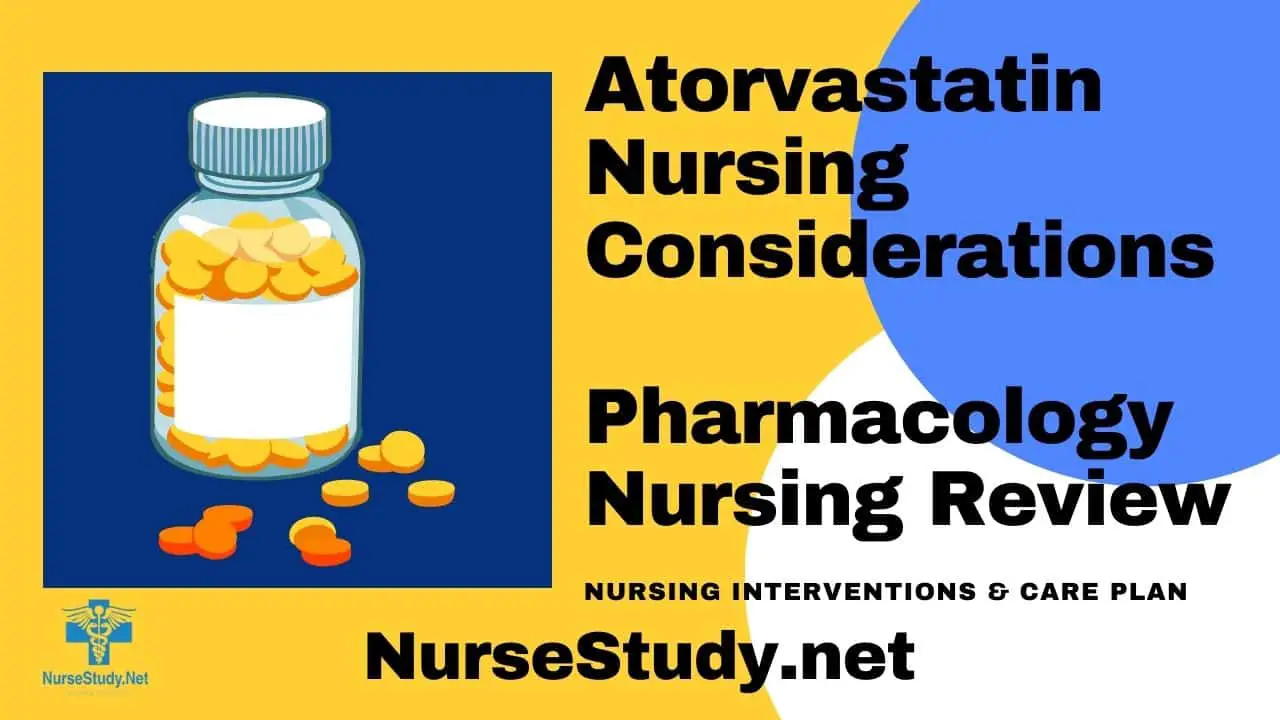Atorvastatin, commonly known as Lipitor, is a medication belonging to the statin class of drugs. It’s widely prescribed to lower cholesterol levels and reduce the risk of cardiovascular disease. As one of the most prescribed medications worldwide, understanding its nursing considerations is crucial for healthcare providers.
Generic name: Atorvastatin
Brand names: Lipitor, Torvast, Atorlip, Atoris
Pharmacologic class: HMG-CoA reductase inhibitor (statin)
Therapeutic class: Antihyperlipidemic
Mechanism of action: Atorvastatin works by inhibiting HMG-CoA reductase, an enzyme responsible for cholesterol production in the liver. This reduction in cholesterol synthesis leads to increased LDL receptor expression and enhanced clearance of LDL cholesterol from the bloodstream.
Indications for use:
- Primary hypercholesterolemia
- Mixed dyslipidemia
- Homozygous familial hypercholesterolemia
- Prevention of cardiovascular disease
- Acute coronary syndrome
Precautions and contraindications:
- Active liver disease
- Pregnancy and breastfeeding
- Severe renal impairment
- History of statin-induced myopathy
- Concurrent use of strong CYP3A4 inhibitors
Drug Interactions
- Grapefruit juice increases drug concentration
- Strong CYP3A4 inhibitors (e.g., clarithromycin, itraconazole) increase the risk of myopathy
- Gemfibrozil and other fibrates increase the risk of rhabdomyolysis
- Cyclosporine increases atorvastatin levels
- Oral contraceptives may increase hormone levels
Adverse Effects
- Muscle pain and weakness
- Liver enzyme elevations
- Gastrointestinal disturbances
- Headache
- Rash
- Sleep disturbances
- Memory problems
- Increased blood sugar levels
- Rare but serious: rhabdomyolysis
Administration Considerations
Available preparations: Film-coated tablets (10, 20, 40, and 80 mg)
Dosages: Initial dose typically 10-20 mg once daily, maximum 80 mg daily
Administration timing: Can be taken any time of day, with or without food
Nursing Considerations for Atorvastatin
Related Nursing Diagnoses
- Risk for impaired liver function
- Risk for injury related to musculoskeletal side effects
- Deficient knowledge related to medication regime
- Risk for ineffective health maintenance
- Noncompliance with the medication regime
Nursing Assessment
- Assess liver function through baseline and periodic liver function tests
- Monitor for muscle pain, tenderness, or weakness, particularly during initial therapy and dose increases
- Evaluate lipid panels regularly to determine medication effectiveness
- Assess for pregnancy status in women of childbearing age
- Review current medications for potential interactions
Nursing Interventions
- Monitor liver function tests (ALT/AST) at baseline and as ordered
- Assess CK levels if the patient reports muscle symptoms
- Monitor lipid panels for therapeutic response
- Document and report any adverse effects promptly
- Provide patient education about lifestyle modifications
Patient Teaching Associated with Atorvastatin
- Take medication at the same time each day to maintain consistent blood levels.
- Report any unexplained muscle pain, tenderness, or weakness immediately
- Avoid grapefruit juice while taking atorvastatin
- Maintain a heart-healthy diet and regular exercise program
- Do not stop taking the medication without consulting healthcare provider
- Women should use effective contraception and report pregnancy immediately
- Store at room temperature away from moisture and heat
- Schedule regular follow-up appointments for monitoring
- Be aware of potential drug interactions, including over-the-counter medications
- Report symptoms of liver problems (dark urine, yellowing of skin/eyes, upper abdominal pain)
Note: This is not an all-inclusive list of possible drug interactions, adverse effects, precautions, nursing considerations, or patient instructions. Please consult with a pharmacist for complete information.
References and Sources
- Mach F, Baigent C, Catapano AL, et al. 2019 ESC/EAS Guidelines for the management of dyslipidaemias: lipid modification to reduce cardiovascular risk. European Heart Journal. 2020;41(1):111-188.
- Ward NC, Watts GF, Eckel RH. Statin Toxicity. Circulation Research. 2019;124(2):328-350.
- Newman CB, Preiss D, Tobert JA, et al. Statin Safety and Associated Adverse Events: A Scientific Statement From the American Heart Association. Arteriosclerosis, Thrombosis, and Vascular Biology. 2019;39(2):e38-e81.
- Rosenson RS, Baker SK, Jacobson TA, et al. The National Lipid Association’s Muscle Safety Expert Panel. Journal of Clinical Lipidology. 2022;16(1):24-39.
